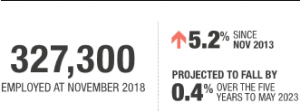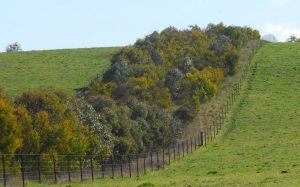
[Image from ‘Sustainable Agriculture is the Way to feed the World: https://agroamerica.com/en/sustainable-agriculture-research/]
Agriculture, Forestry and Fishing
https://australianjobs.employment.gov.au/jobs-industry/agriculture-forestry-and-fishing


While current projections for agricultural employment indicate a slight decline, the reports below suggest potential for employment growth and value creation.
With regard to conventional farming this relates to technology adoption and national level data, getting more from innovation and (digital) data, and investing in off-farm R&D – creating value up the chain. (See Acil Allen report: ‘Agriculture – a 100 billion sector by 2030?’).
The CSIRO has identified significant potential for value adding through food products for consumers prioritising sustainability and health aspects. (See Growth Opportunities for Australian Food and Agribusiness).
Several sources including the Commonwealth Department of Agriculture, Fisheries and Forestry, the CSIRO and Professor Ross Garnaut see major economic and environmental benefits from soil carbon farming.
A number of reports have identified both growth potential and limiting factors for agricultural development in Northern Australia. Despite limiting factors, there is consensus that growth potential exists.
There is broad consensus across farming organisations and the agricultural supply chain that sustainable agriculture is an important priority. Analysis of what kinds of agricultural practices are most sustainable is beyond the scope of this site.
The articles in this file contain a broad range of perspectives on prospects for carbon farming, conventional farming and the agricultural potential of northern Australia. Several articles relate to the role of science in supporting sustainable agricultural development.

Image from Sustainable Agriculture Initiative:
The Australian Sustainable Agriculture Initiative (SAI) Platform came together in 1997 from across food and beverage value-chain to provide practical and commercial perspectives on issues and policies that impact Australia’s agricultural sector.
The SAI aims to inform and advise on the key issues that impact sustainable food and beverage production in Australia. It undertakes activities and actions that could benefit the sector, including trialing approaches, implementing specific sustainability practices and encouraging R&D involving supply chain participants, and it partners with business, government and other networks to drive improved sustainability.
The SAI’s focus is connecting the farm-gate, manufacturers, buyers, policy makers, retailers, academics and investors to solve problems in the best interests of the industry, our farmers and productivity. SAI members are actively undertaking sustainability actions within their own businesses and organisations. Members also share knowledge and information in areas of common interest (at the pre-competitive stage). Members have developed and are committed to a suite of sustainability guidelines covering environmental, social and economic aspects.
http://www.saiplatformaust.org/about-us
2018 Northern Australia Case Study – ACIL Allen-pdf
This Acil Allen case study relates to two CSIRO research projects on northern Australian development:
— The development of the Transport Network Strategic Investment Tool or TraNSIT.
— The Flinders and Gilbert Agricultural Resource Assessment (FGARA) which evaluated the feasibility, economic viability and sustainability of agricultural development in the Flinders and Gilbert catchments in the Gulf country of North Queensland.
It is included to highlight the role of science in supporting regional development and employment.
1.2 Background [excerpt]
CSIRO, as Australia’s national research agency, has supported the development of northern Australia for many decades. CSIRO’s agricultural research commenced in northern Australia in the 1930s with the aim of supporting the development of the beef cattle industry. That research has produced many important outcomes. For example, it has:
— identified a number of agricultural and pastoral opportunities across northern Australia
— led to the introduction of tick-resistant cattle
— led to the introduction of dung beetles
— led to the introduction of a number of tropical legumes as pasture plants
— developed cotton varieties that are insect-resistant and adapted to growing in the tropics
— mapped much of northern Australia’s soil and landscapes
— developed cropping systems adapted to northern Australia
— worked closely with industry to breed and introduce new sugar cane varieties as well as bringing genetic material from China into Australian varieties.
CSIRO’s research in support of the development of northern Australia continues to this day. It has expanded to include research to support the minerals and energy, tourism, wildlife, Indigenous knowledge, defence and fisheries industries as well as the emerging carbon economy. It has worked by directly supporting these sectors, as well as providing science that underpins the establishment and growth of industries and communities in the north more generally. CSIRO has around 200 current or recent projects with direct relevance to northern Australia. CSIRO’s projects includes initiatives to improve northern Australia’s hard and soft infrastructure, economic value chains, Indigenous knowledge and land management, Indigenous economic development, public health, land and water management and understanding of northern Australia’s environment.
Acil Allen report: ‘Agriculture – a 100 billion sector by 2030?’
Excerpt from Foreword: ‘Agriculture is Australia’s fastest growing sector and second only to mining in terms of its importance to the national economy – contributing more than $63 billion or 2.3% to Australia’s GDP in 2016-17.’
The report analyses the National Farmers Federation Road Map to 2030, setting out steps to reach the 100 billion figure.
Drivers for growth are identified as
Driver 1: Technology adoption and national level data, getting more from innovation and (digital) data
Driver 2: Investing in off-farm R&D – creating value up the chain
Driver 3: Investing in off-farm infrastructure
Driver 4: Market access and market development
Section 3 discusses defensive considerations, including: Risk 1: Climate change and water availability
GrowthOpportunitiesAustralianFoodAgribusiness
CSIRO Report: Growth Opportunities for Australian Food and Agribusiness
Points include:
Opportunities in wellness, sustainability and premium markets may contribute to industry growth
Demand from the Asia-Pacific is likely to underpin export growth in food and agribusiness
NAWRA_Ag_Viability_factsheet_v5_final
CSIRO: Exploring agricultural production and viability in northern Australia (Part of the Northern Australian Water Resource Assessment)
Soil Carbon Brochure/Factsheet, Commonwealth Department of Agriculture, Fisheries and Forestry
Regional Australia Institute: Rethinking the Future of Northern Australia’s Regions: More than mines, dams and development dreams: http://www.regionalaustralia.org.au/wp-content/uploads/2013/11/Rethinking-the-future-of-northern-Australias-regions1.pdf
talking-2030-growing-australian-agriculture
KPMG Report, on growing agriculture to 100 billion in 2030.